ST. JOHN'S, N.L. — It just got more expensive for the provincial government to borrow money.
Moody’s, one of the three credit rating agencies that shape how much it costs Newfoundland and Labrador to borrow money, has downgraded the province’s credit rating from Aa3 with a negative outlook to A1, the company announced on Wednesday. The new rating is the fourth highest in the Moody’s 21 level credit rating scale.
Moody’s points to three areas of higher risk than the company previously forecasted: the growing debt burden of the province; the weak financial state of Nalcor Energy; and the rate mitigation plan outlined by the Liberals to keep electricity rates low.
On the debt burden, Moody’s says the provincial net debt ($14.2 billion) is expected to rise to 257 per cent of annual revenues ($6.2 billion in 2019-10) in 2021, while falling down to 250 per cent in 2022. The 2022 figure would give Newfoundland and Labrador the highest revenue to debt ratio in the country.

High provincial debt means high interest payments.
Currently, the province spends $1.3 billion on debt servicing, the second largest expense for the province. K-12 education and post-secondary education combined account for just over $1.4 billion in expenses for the province.
Memorial University economist Wade Locke says it’s hard to quantify exactly how much more expensive it is now for the province to borrow money, but the change will drive up the price.
“You have to recognize there’s a problem and that if you don’t deal with the problem it’ll get worse – it’ll come back to haunt you,” said Locke.
“We’re not in a situation where we’re going to go bankrupt. That’s what people think, but that’s not the case. But it does mean that at some point it’ll cost more to borrow. You may not be able to borrow as much as you’d like. That’s the problem.”
Finance Minister Tom Osborne isn’t fazed by the downgrade, saying that lenders were expecting the decrease. Osborne says government’s plan to fix the fiscal state of the province is unchanged after the downgrade.
“We’ve maintained our budget targets in large part over the last three years. Every year you see something – we saw a shutdown in the oil industry last year. We see Hibernia affected today. There’s always detours or bumps in the road,” said Osborne.
It’s that volatility in revenue that Moody’s points to as another reason for the downgraded rating.
“The province faces higher levels of volatility surrounding revenues relative to other provinces, given material levels of revenues stemming from specific offshore oil projects,” reads the report.
“This volatility hampers long-term planning relative to other Canadian provinces and is an intrinsic credit negative of the province.”
Moody’s also says the rate mitigation plan from government is “untested,” adding to fears that the fiscal state of the province could further decline.
Michael Yake, a vice president and senior credit officer with Moody’s, says none of the three factors are more or less significant than the others toward the downgrade, but there needs to be more certainty around the rate mitigation plan before lenders will feel more comfortable.
“Even though the province has come out with the 10-point mitigation plan, what we felt the elements of the plan are untested and unproven at this point. The fact that it takes ten different elements to get to the amount that’s required for rate mitigation highlights that if any of those fail, the rate mitigation plan may not succeed,” said Yake.
“In our opinion, that highlights the additional risk that the province may still end up ultimately having to support Nalcor either directly or indirectly through some sort of taxpayer support to mitigate the rate increases.”
“Even though the province has come out with the 10-point mitigation plan, what we felt the elements of the plan are untested and unproven at this point. — Micheal Yake
One major hole in the $725-million rate-mitigation plan is a $200 million offering from the federal government. To date, no agreement to supply those funds is in place, and Osborne couldn’t say for sure if the agreement will be in place ahead of the coming federal election.
Tory finance critic Tony Wakeham says it’s troubling to see the gap.
“Way back when they made this big announcement of the (federal) minister of Finance coming to town and it was a fait accompli,” said Wakeham.
“Now we’re hearing that there is no $200 million. There’s nothing in writing. That’s a little bit disappointing for the minister to come forward with that. He made it clear today that they have no guarantee of that $200 million.”
New Democratic Party Leader Alison Coffin says her party is not advocating for increased expenses in future budgets, but rather for incremental legislative change that will have less impact. Coffin says there are certain one-time expenditures on the books that, when dealt with, will help show lower expenditures than seen today.
“In this recent budget, we had an enormous amount of money going towards Muskrat Falls – we’re subsidizing that. We’ve tucked $111 million away for the Equinor project. That’s just sitting there,” she said.
“Those two are expenditures that will not be happening a couple of years down the road. All of a sudden, you’ve captured some savings already.”
Similar credit reports from DBRS and Standard & Poor’s are expected to be released in the coming weeks.
Twitter: @DavidMaherNL
RELATED:









